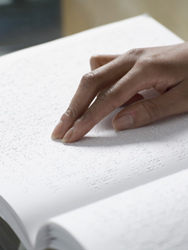High-tech interface for the blind
Society has not always provided equal opportunities to blind or visually impaired individuals, particularly in the information age where more can be done to facilitate access to knowledge. An interface device that is anaglyptic and touch-sensitive (i.e.resembling a board full of individual pins) could give the visually impaired a major tool to access a computer or read information. In conjunction, the use of photo-haptic technology that exploits the sense of touch and infrared lasers can also help produce innovative interface equipment for visually impaired people.With this in mind, the EU project 'Anaglyptic refreshable photo-haptic screen' (ANAGRAPHS) rose to the challenge. It worked on developing an anaglyptic or tactile display that connects to a personal computer or that could stand alone as a Braille e-book reader. The project team envisioned a device that could display Braille characters but also other visual data, opening users to a whole world of knowledge. Building a prototype device required thermo-hydraulic micro-actuation where each Braille dot is activated by a heating system controlled by microprocessors. The prototype employed simple waxes that change from solid to liquid to help create a powerful interface. This also involved the development of sophisticated software and housing components. In parallel to creating the prototype, the project team developed a cost model for the device. It showed that the product could be very cost effective and prove competitive on the market. It then tested the system in partnership with the University of York in the United Kingdom to assess the functionality, performance and market needs, exploring ways to drive costs further down. Described as the Holy Grail for the visually impaired and blind Braille users, the device could revolutionise how blind people interact with information from the outside world.







